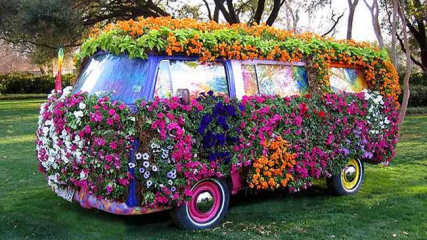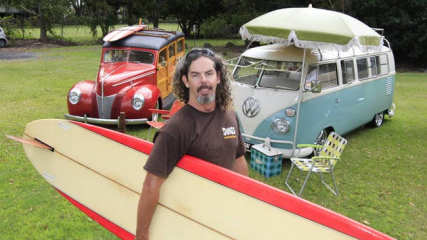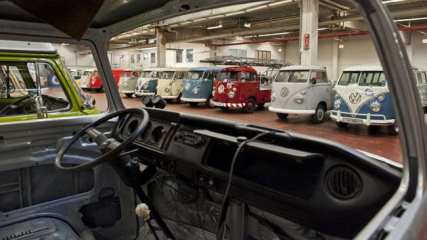Volkswagen Kombi News
.jpg)
Porsche Vision 357: Why looking to the past is important for the German brand's future
Read the article
By Stephen Ottley · 26 Jan 2023
Porsche has given itself a birthday present, but there’s a lot more to the Vision 357 than just a celebration of the brand’s 75th anniversary of building sports cars. The Vision 357 is the latest concept car from the Style Porsche department, taking inspiration from the brand’s original sports car - the now-iconic 356 - but underpinned by the latest 718 Cayman GT4 RS powertrain.
.jpg)
From Toyota HiLux to Volkswagen Beetle and Citroen DS: The old petrol and diesel cars that are ripe for EV conversion to electric cars
Read the article
By David Morley · 24 Dec 2021
One of the rapidly emerging themes around CarsGuide is the rise of the electric car. And within that, there’s a healthy debate going on around the conversion of conventionally powered cars to electric operation.

VW Kombi EV plans confirmed ahead of 2022 release
Read the article
By Matt Campbell · 28 Jun 2019
The all-electric, all-new version of the Volkswagen Kombi will make it to production in 2022, the brand’s commercial vehicles arm has revealed.Volkswagen Commercial Vehicles plant in Hannover will be the production site for the production version of the ID Buzz, which the company describes as “a new version of the Volkswagen Bulli brand icon”. For the unaware, “Bulli” is the go-to nickname for the Kombi in Germany, just like "Microbus" is the preferred term in the US.In 2022 the new version will start rolling down the production line, with chairman of VW Commercial Vehicles board of management, Thomas Sedran, stating the company’s expansion into EVs and self-driving cars will mean the new Kombi will change the way people think about people movers.“The Bulli of the future will come from Hannover! This secures the future of the brand and also of the site,” said Mr Sedran.“We are investing several billion euros in sustainable mobility for light commercial vehicles, a large part of it in electric mobility. Together with the workforce, we want to take this drive technology to a new level in its everyday use.”Mr Sedran explained that it won’t only be EV models built in Hannover - that the company will also produce diesel engines in the years to come, and also focus on hybrid models, too.VW has confirmed the ID model range - which will also include a smaller hatchback, a cargo van and SUV - will be aimed at China and North America primarily, but VW Australia is believed to be keen to have the electric Kombi as part of its line-up.

Classic Volkswagen Kombi sells for $158k
Read the article
By Joshua Dowling · 01 Dec 2015
Foreign buyers are paying top dollar for classic VW Kombis and shipping them back to Europe where they can get even more money for them.

The tax grab that nets family cars
Read the article
By Joshua Dowling · 30 Aug 2015
Almost 200 luxury cars are now exempt from Luxury Car Tax, so why do buyers of family cars pay millions for the tax-on-a-tax each year?
.jpg)
VW Kombi love is alive and well
Read the article
By James Stanford · 20 Mar 2015
MARCH, 1950: Volkswagen started building its second ever vehicle, known in the factory as the Type 2 or the "Bulli" but later to be called the Kombi.
.jpg)
VW Kombi sets world record at auction
Read the article
By Chris Riley · 24 Feb 2015
The price, paid by an unnamed telephone bidder after a relentless battle with several rivals in the auction room, was substantially more than the $135,000 paid for a hero 1969 Falcon XW GT in award-winning unrestored condition.It was also more than double the price paid for a 1968 Holden HK GTS Monaro 327 Coupe – also in unrestored condition – that sold for $96,000.The VW Kombi's result brought a standing ovation from the large crowd that had packed into Shannons Cheltenham, Melbourne showroom.Early Kombis have attracted a cult following around the worldIt capped off a night of top prices paid for many of the 39 classics on offer - 21 of them presented for sale with 'no reserve' (an auction trend championed with growing success by Shannons).Based on the national and even international interest that was shown in the Microbus before the sale, Shannons was quietly confident that the humble VW – fresh from a five year restoration – would top pre-auction expectations of $120,000-$140,000.Once the preserve of hippies looking for cheap, live-in transport, early Kombis have attracted a cult following around the world, with top examples routinely fetching six figure sums overseas in recent years.The Volkswagen Type 2 was introduced in 1949 and rapidly established itself as one of the most versatile and popular commercial vehicles ever made.The Kombi is finished the delightful two-tone period colours of Paprika and White with contrasting tan upholsteryThe first examples were seen in Australia in 1953 and were assembled at VW's Clayton plant in Melbourne from 1954.The 'step-through' T2 Deluxe Microbus with its period 'Golde' folding roof – widely regarded as the most collectible Kombi of all – was completed on December 13, 1960 and first delivered in Melbourne.Beautiful in every detail, the Kombi is finished the delightful two-tone period colours of Paprika and White with contrasting tan upholstery.It has been the recipient of several awards, including President's Choice at the Volkswagen Club of Victoria's ‘Day of the Volkswagen' in 2013.The Kombi's sale near the end of the auction almost took the wind out of the sale, despite excellent results being posted by a number of other lots.Shannons National Auction Manager, Christophe Boribon said the result set a very positive tone for Classic vehicle sales in 2015."This is a spectacular result for our first auction of the year," he said.

VW Kombi killed off | 20 reasons we loved it
Read the article
By David Burrell · 31 Dec 2013
And so it goes. Another automobile icon fades from view because of 21st century safety regulations. After 64 years of production, the final Volkswagen Kombi will roll off the production line today -- this one in Brazil where the more relaxed safety regulations allowed the Kombi to continue, and where they have been built for the past 56 years.And it travelled a long way. The vehicle that came to symbolise the counter-culture around the globe started out as an idea on paper for the war ravaged VW to make some much needed money. The Kombi is now one of the few cars in the pantheon of true classics. More than any other automobile, the VW Kombi is an enduring image of the flower-power hippy era in the 1960s and of the wider surfing culture across the world.Cheap, plentiful and able to carry big loads with ease it was an ideal vehicle for a newly mobile, baby boomer generation. The first series Kombi was released for sale in 1950, after its appearance at the November 1949 Geneva Motor Show. Its heritage goes back to when the British Army occupied and ran the VW factory in Wolfsburg, Germany, after the end of Second World War.There are various versions of how the Kombi came to be, but the main facts are agreed. Needing a vehicle to move parts around the VW factory, the Army cobbled together a strengthened Beetle chassis, surrounded it with a utilitarian panels and created a small truck.In 1947 a Dutch VW dealer, Ben Pons, saw these little trucks while visiting to the factory. He thought that with some improved body panels it would make a cheap, sturdy and light truck to be used in the rebuilding of the war torn Europe. He sketched a design for VW managers and went back to Holland.Heinz Nordhoff, who was ex-Opel, and been installed by the Army to run VW, took up this idea and made it happen. The rest of the story is legend. Kombis have a strong fan base and devotes of the vehicle have their own language to describe the “buses”. Those built between 1950 and 1967, are known as split-window buses or 'splitties' because of the divided windscreen.Those built after 1967 have a one piece screen and are known as the 'bay window' Kombis. Prices for early models continue to rise, across the world. In Australia models from the 1950s can run to $45,000 and above, particularly the 'barn door’ versions in good condition.So if you are in the market for a real classic, buy a Kombi now. The price will only rise. Apart from their investment potential, we love the Kombi for many reasons.

My 1940 Ford Woody and 1962 VW Kombi
Read the article
By Mark Hinchliffe · 26 Apr 2012
The 46-year-old Gold Coast earthmoving contractor has wisely used Australia's high dollar to negotiate good prices on a couple of classic surfing vehicles from America - a 1940 Ford Woody wagon and a 1962 split-windscreen VW Kombi."They take you back to a time when life was simple," he said. He and wife Fiona bought the Woody six months ago for about $30,000 and already they have knocked back an offer of $120,000 while the Kombi cost $35,000 and has attracted offers up to $80,000."The guy who sold me the Woody sent it with two Malibu surfboards and I drove around for five days before I realised he had also left a Beach Boys greatest hits CD in the stereo for me," he said. "That was the heart-melting moment of that car. He was just so in touch with what we wanted."Every time we take these vehicles out someone offers money or wants a photo taken with them. They bring out the child in people." Shannons Insurance national auction manager Chris Boribon confirmed the trend toward collecting surf-culture cars, especially "Woodies" which are wagons with a wood panel down the side. "A good Woody left in its original state and not modified is definitely a very collectible car," he said. "They have some style about them and they give us fond memories of the surf culture back in the '50s and '60s."However, Boribon warned that restorers of Woodies would not only need mechanical knowledge, but also woodworking skills. Some US internet sites are advertising Woodies at up to $200,000, but Boribon suggested more-affordable Australian Woodies worth collecting include the Ford XL and XM Falcon Squire wagon. "They are a very collectible thing, but they are quite hard to find," he said. Watson will add his surf-culture cars to his growing collection of classic vehicles which he plans to hire through his new business, Woody's Surf Car Hire, catering for private functions such as weddings, as well as movie props. Watson says he has bought and sold more than 100 vehicles since his parents gave him a HT Holden station wagon at the age of 15. "I grew up in a family where my father and brothers worked for GMH at Acacia Ridge and were Holden men through and through," he said. "I'm not a diehard Holden fan. I appreciate all the cars." Yet his collection says otherwise with a 1968 HK Monaro GTS, 1971 HQ drag car and 1969 HG panel van also in his garage.

VW Kombi classic centre opens
Read the article
By Neil Dowling · 03 Apr 2012
VW has put the call out for its boxy Kombi children to return to the vans' birthplace for rejuvenation.
Volkswagen has opened a huge restoration centre at Hannover - the home of the Kombi since the van's origin in 1950 - to cater for the cult-car's burgeoning demand for restoration work.
The company says it's serious about its heritage, changing tack from working on its own heritage cars to taking on private work. The classic centre, called Volkswagen Commercial Vehicles Oldtimers, is now headed by a former chief executive and currently classic director of Audi, Bentley and Bugatti, Franz-Josef Paefgen.
The Oldtimers department of Volkswagen Commercial Vehicles has 100 buses on show - all bought and restored by the centre - and this year moved into a new 7000sqm facility in Hannover, Germany.
It has 13 staff - from mechanics to a technology historian and an event planner - to restore and preserve the vehicles and its own paint shop. Volkswagen says that no matter whether a full or partial restoration is required, or a bus is simply to be made roadworthy, the "Bulli'' workshop team will undertake any assignment.
"Paint renovation or an inspection is also possible. The staff talk through all personal restoration wishes with the customer before preparing an individually tailored offer,'' the company says in a statement.
"The unique feature is that only here does the customer receive certificated ex-works restoration. In addition, for each customer the team of Volkswagen Commercial Vehicles Oldtimers provides comprehensive documentation of the restoration of the vehicle, in which every step is photographically documented and described in detail.
"Thus the work performed by the specialists from Hannover is recorded for posterity, and customers can leaf through their folder whenever they wish.'' Volkswagen Classic Parts, which continues to make components for it older models, supports the Oldtimers centre as a partner.
"Some of the replacement parts needed when working on oldtimers are even taken from Volkswagen's original stock,'' Volkswagen says. Volkswagens from all around Australia converge on South Australia this weekend for the annual National Bug-In. The event, first started in 1970, this year focuses on McLaren Vale, Aldinga Beach and Port Willunga.





